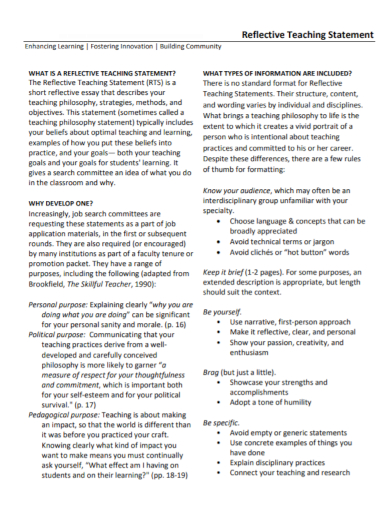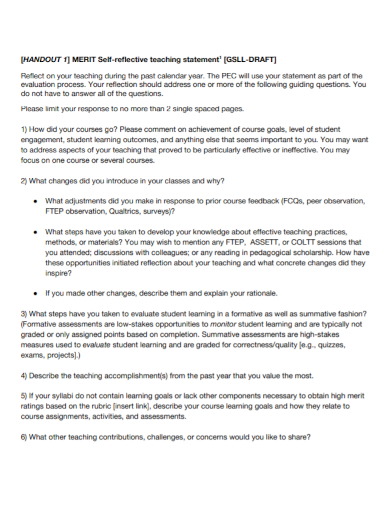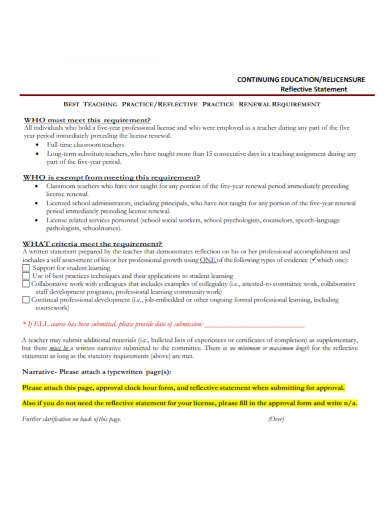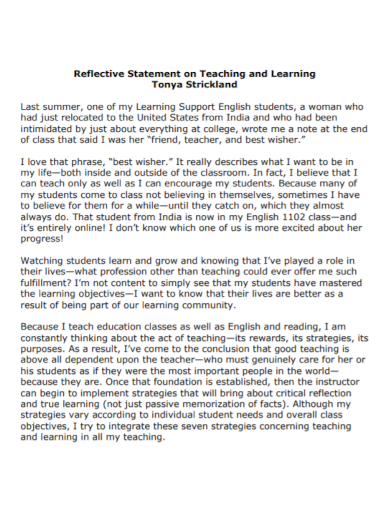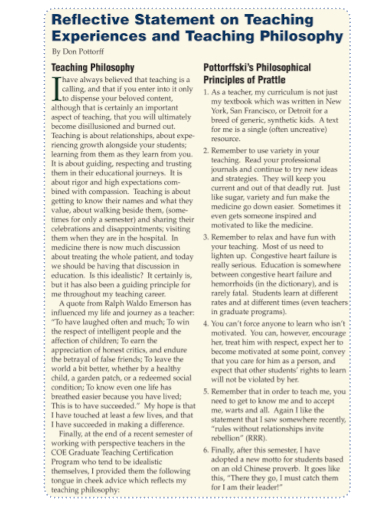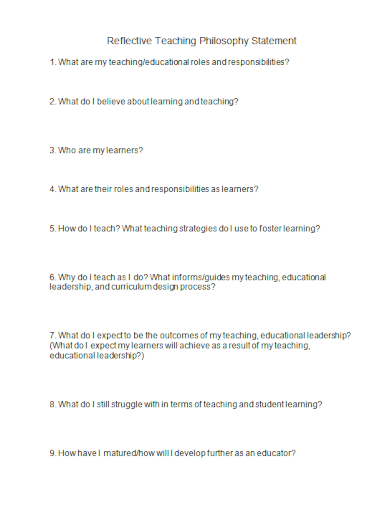Reflective statements are an academic style of writing in which teachers focus on describing their assessment of their teaching practices from the past and gathering any lessons from their mistakes and achievements to help them realize in which fields they could revise their teaching styles. A reflective teaching statement usually requires around 300-500 words so brevity is essential in writing a reflective statement. Writing a reflective teaching statement is tricky, especially for individuals who are practice teaching and has not yet encountered writing such a thing. If you’re a teacher who is a novice at writing these statements, this article can guide you on how to write a reflective teaching statement.
6+ Reflective Teaching Statement Samples
1. Reflective Teaching Statement
2. Sample Reflective Teaching Statement
3. Self Reflective Teaching Statement
4. Education Reflective Teaching Statement
5. Reflective Teaching and Learning Statement
6. Teaching Experience Reflective Statement
7. Reflective Teaching Philosophy Statement
What is a Reflective Teaching Statement?
A reflective teaching statement is an essay-like paper that is written in a narrative style to describe the teaching experiences of teachers and the values and methods of teaching and learning that have become important to them. The statement is written in the own honest and subjective view of the teacher.
Guidelines of Writing a Reflective Teaching Statement
Below is a list of guidelines and some questions to help you write the contents of your reflective teaching statement. You can begin by answering all the points below as your initial draft. After you’re done, look for any themes or patterns that can help you to organize your statement.
1. A Change in Your Classroom Teaching
The first paragraph will be your introduction. You can start by telling the most meaningful aspects of your teaching experience. You can then transition to defining the teaching values, goals, and methods when you first started. To expound on that idea, describe the learning outcomes you were trying to achieve in the course you’re teaching. Describe your previous methods by explaining one or two practices you used before and why you chose to do those. Then, describe all the teaching methods and strategies that you changed and how you implemented them. Include the factors that made you do the changes such as attending workshops or consulting with teaching experts.
2. Your Assessment in Your Teaching Practice
The next part to include in your statement is to assess your new practice. For example, you can discuss how you measured the effectiveness of your new practice and how it is a great improvement compared to your previous practices. You could include midterm survey results, or presenting a simple rubric to track student skills in specific areas. The new technique does not have to be a success, but a thoughtful informed effort toward improvement.
3. Your Goals for Your Future Teaching Practice
The next part to include in your statement are your new goals in your teaching practice. Discuss how you will adjust your next course after reflecting on your assessment. For example, you have plans to contribute to curriculum redesign, or introducing new effective types of mentoring activities for your students.
4. Other Aspects to Reflect About
You can end your statement in the previous section but if you have more space to add a last and memorable reflection, you are free to do so. You can include highlights of your experiences or muses that you’d like to pursue in the academic field. For example, you can talk about what aspects of the teaching and learning process you wish to know more about or share some of your interesting experiences of working with diverse students.
FAQs
What are the five Rs of reflection?
The 5Rs framework for reflective writing are reporting, responding, relating, reasoning, and reconstructing.
What is effective teaching?
Effective teaching is the ability that teachers must possess to improve student achievement. Effective teaching depends on the teaching factors such as teacher behavior, teacher knowledge, and teacher beliefs.
What are the qualities of a good teacher?
The qualities that make up a good teacher are good skills in communication, listening, good collaboration, adaptability, empathy, and has long patience. A good teacher could also have an engaging classroom presence, value in real-world learning, and a love of learning.
When you’re done drafting your reflective statement, review it and revise if there are any grammatical and spelling errors. This is a formal writing paper, so it must be free from those. Let a colleague read your statement to let you check if your statement is written properly and welcome their suggestions on how you can improve your statement. To help you start writing your statement paper, refer to our free sample templates provided above!
Related Posts
FREE 10+ Ethical Statement Samples
FREE 10+ Leadership Statement Samples
FREE 10+ Ethical Statement Samples
FREE 10+ Informative Thesis Statement Samples
FREE 10+ Academic Statement of Purpose Samples
FREE 8+ Teacher Resume Templates
FREE 8+ Letter of Intent Graduate School
FREE 6+ Teacher Resume Objective Templates
FREE 5+ Sample Letter of Recommendation for Teaching Position
FREE 16+ Teacher Lesson Plan Samples
FREE 10+ Informative Speech Thesis Statement Samples
FREE 10+ Church Action Plan Samples
FREE 10+ Leadership Statement Samples
FREE 8+ Sample Resume Objective Statement
FREE 8+ Sample Teacher Assistant Resume

